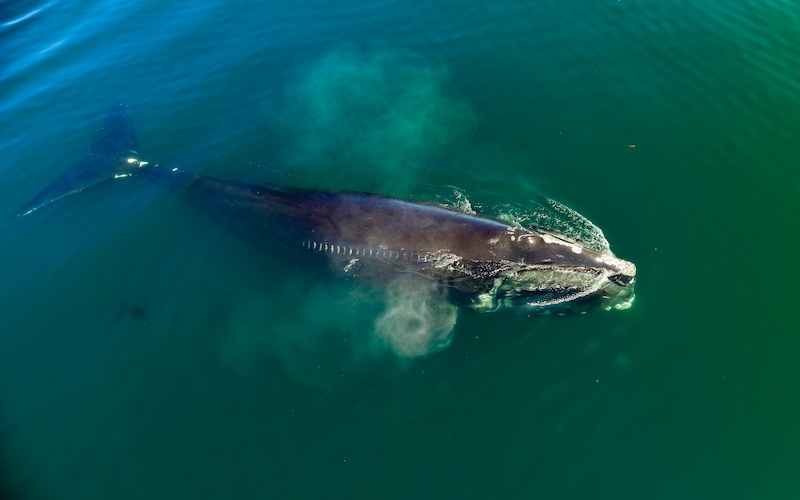
Photo: Brian Skerry/Steve De Neef
July 29, 2022 (WASHINGTON)— The National Marine Fisheries Service proposed a rule today to better protect critically endangered North Atlantic right whales from being run over and killed by vessels in U.S. waters. Vessel strikes are one of the two primary threats to right whales; the other is entanglement in fishing gear. The right whale population stands at no more than 340 surviving animals.
“We are glad that NOAA is finally taking action to protect both whales and boaters. Just like slowing down in a school zone, speed zones on the water give boaters and the whales a chance to react and move out of harm’s way,” said Regina Asmutis-Silvia, executive director of Whale and Dolphin Conservation’s North American office. “If you think hitting a deer with a car is dangerous, imagine striking a 40-ton whale with a fiberglass boat.”
Whale and Dolphin Conservation, Defenders of Wildlife, Conservation Law Foundation, and the Center for Biological Diversity filed a legal petition in August 2020 asking the Fisheries Service to expand the areas and times when its existing 10-knot vessel speed limit rule applies to make all voluntary vessel speed restrictions mandatory and to apply the rule to small vessels (shorter than 65 feet) as well as large ones to avoid collisions that kill and injure right whales.
The 2020 petition was in direct response to the loss of three right whales, including a mother and calf pair, from collisions with small vessels in less than a year. Three of these groups had made similar requests in a previous 2012 petition. The existing vessel speed regulation, first promulgated in 2008, has never been updated despite ample evidence that vessels were still striking and killing right whales at unsustainable rates.
When the agency failed to act on either petition, the groups filed a lawsuit in federal court in January 2021, challenging the agency’s unlawful failure to act on the petitions and demanding that the agency increase protections for right whales. That case is fully briefed but the judge has not yet issued a decision.
Today’s proposed rule would create new seasonal speed zones, apply the rule to most vessels greater than or equal to 35 feet in length, and create a dynamic speed zone framework to implement mandatory speed restrictions whales are observed or acoustically detected outside active seasonal speed zones. The proposed rule also includes updates to the safety provision, which would allow vessels less than 65 feet in length to deviate from the speed restriction under certain conditions.
“There are fewer than 70 reproductive females left to birth the next generation of right whales, “said Jane Davenport, senior attorney at Defenders of Wildlife. “Mothers and calves are especially vulnerable to speeding boats in their calving grounds off the southeastern U.S. from South Carolina to Florida. The Fisheries Service must finalize new vessel speed limit protections before the next calving season starts this winter or literally risk the species’ future.”
North Atlantic right whales are among the world’s most endangered large whales. Thirty-four right whales have been found dead since 2017, and the Fisheries Service believes at least another 17 have died or will die, from existing injuries. The agency estimates the actual number of deaths each year is much higher since most right whale deaths are not observed.
“Given the glacial pace of new right whale protections over the last decade, immediately curtailing the second biggest threat to their existence would be a game-changer,” said Erica Fuller, senior attorney at Conservation Law Foundation. “This proposed rule is a major step forward, but there’s a five-month gap in protection south of Martha’s Vineyard and Nantucket that should be addressed. Federal officials must now get these protections in place on the water as quickly as possible and effectively enforce them.”
The existing speed rule applies only to vessels 65 feet and longer and sets seasonal speed limits in historic right whale habitats along the U.S. East Coast but does not include areas where right whales are now known to aggregate. It also establishes a voluntary dynamic management system whereby vessel operators are asked, but not required, to slow to 10 knots or less when a group of three or more right whales is seen in an area. The Fisheries Service’s own monitoring systems confirm that vessels rarely slow down voluntarily.
“Ship speed limits save whales, so it’s tragically ironic that the Fisheries Service moved so slowly to make this proposal,” said Kristen Monsell, oceans legal director at the Center. “This proposal is a step in the right direction, but it won’t help a single right whale until it’s actually finalized. The Fisheries Service needs to get this rule in place as quickly as possible. As right whales spiral toward extinction, they just can’t wait any longer for protections against getting run over and killed by vessels.”
The proposed rule will be open for a 60-day comment period.
Experts are available for further comment.
###

